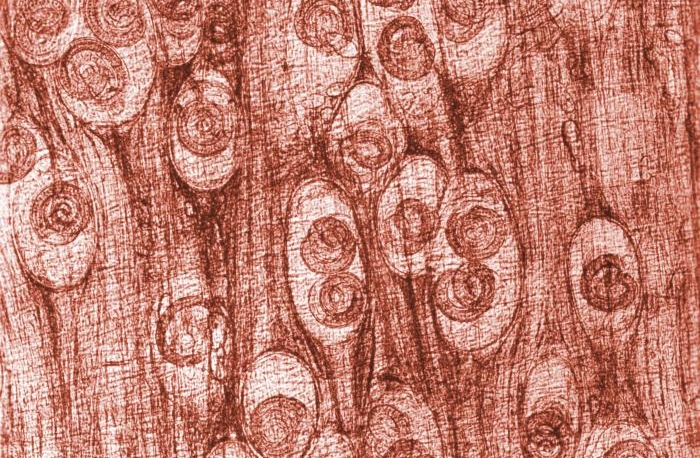When a 4,000-year-old skeleton located in Rajasthan, India was unearthed in 2009, archeologists were not expecting to find Mycobacterium leprae present (1). This finding provided the earliest known evidence of the bacteria that causes leprosy, also known as Hansen’s disease, in humans. The finding has helped researchers hypothesize how the disease spread between Africa and Asia as early as 2000 BC. Despite having a long history of spread across the globe, leprosy remains one of the least understood infectious diseases, even though it infects approximately 250,000 individuals a year globally (2).
Many individuals may believe they are familiar with leprosy due to its many references in the Old and New Testaments of the Bible. However, the leprosy we experience today is not the same disease as described in the ancient text (3). The conditions described in the Bible could include a wide range of conditions such as fungal infections, impetigo, vitiligo, phagedenic ulcer or scabies, but theologians and researchers state that there is no significant evidence that Biblical leprosy and Hansen’s disease are one in the same (3, 4). As time has progressed, translations of the Bible called the “cursed” and “condemned” disease leprosy, which fueled stigma associated with the disease, ostracizing those suffering to this day (4). Believing that those with leprosy are “marked by God”, it was not uncommon for communities to exile and isolate people infected with leprosy into colonies of their own, where they remained separated from society until their deaths. Because of the stigma attached to the disease, people feared it was highly contagious and deadly, however, this assumption was incorrect (2). In reality, leprosy has an extremely low risk of transmission, and the forced isolation of those with leprosy into their own communities had only tortured them emotionally instead of working to find an effective treatment until the early twentieth century (2).
If contracted, the bacterium M. leprae can take years to develop into clinical disease, but when active disease becomes present, it causes damage to skin, nerves and mucous membranes (5). On the skin, leprosy can result in discolored patches that could be numb and appear to have faded pigmentation, or cause growths, ulcers or thickening of the skin (5). If spread to the nerves, it can cause numbness, muscle weakness or enlarged nerves (5). If facial nerves are affected, eye problems may occur that could potentially lead to blindness (5). In the mucous membranes, nosebleeds are the most common symptom (5). When left untreated, advanced leprosy can cause chronic, non-healing ulcers, blindness and paralysis. However, it is important to note that leprosy is not commonly associated as a direct source of mortality, rather, indirect effects of the disease, like infections, are typically the cause of death in those infected (6). When diagnosed, leprosy is completely treatable and curable using multidrug therapy including rifampicin, clofazimine and dapsone that has been used since 1981 (7). The World Health Organization (WHO) works closely with manufacturers of the treatment to the drugs for leprosy are readily available at no charge to all endemic countries, to make sure everyone who has the disease can be treated (7).
It is still unclear how leprosy spreads between people, however, close contact with an individual with untreated leprosy over an extended period of time, lasting many months, is necessary to contract the disease (8). A person cannot get leprosy from casual contact like hugging, sitting next to a person, shaking hands, through sexual contact or from a mother to infant during pregnancy or childbirth (8). Furthermore, once a person begins treatment for leprosy, they are unable to spread the disease, which means leprosy can only be contracted through extended contact with someone who has not received any treatment (8). Scientists believe transmission may occur through inhaling infected droplets, such as a cough or sneeze, that contains the bacteria (8). Because of the slow progression of disease, it is often difficult to find the direct source of infection (8). Furthermore, transmission is very low because it is estimated that more than 95% of all people worldwide have a natural immunity to the disease (8).
In the United States, 178 new cases were reported in 2015, with 72% of those cases originating in Arkansas, California, Florida, Hawaii, Louisiana, New York and Texas (9). Interestingly, data has confirmed that there is a link between cases of leprosy occurring in individuals who have not traveled outside of the United States, and armadillos, which are the only other known natural host of leprosy in the world (10). Researchers found that 64% of human cases and 85% of armadillo cases of leprosy share the same M. leprae genotype. Globally, the countries with the highest rates of leprosy include the Democratic Republic of Congo, Ethiopia, Madagascar, Mozambique, Nigeria, the United Republic of Tanzania, Bangladesh, India, Indonesia, Myanmar, Nepal, the Philippines, Sri Lanka and Brazil (8). All of these countries reported at least one thousand cases of leprosy between 2011 and 2015, with India reporting 127,326 cases in 2015, accounting for 60% of all new global cases (8).
In order to fully eliminate leprosy, we must first tackle the stigmatization that has a millennium of history behind it. It will not be an easy feat, but through education and increased accessibility to healthcare, people can be treated sooner and remain within their communities without fear of exile. We need to understand why that five percent of the population does not have natural immunity and how we can protect them from contracting the disease. Without full participation of endemic communities, there can be no hope that the burden of leprosy can be eliminated and the stigmatization of the disease to no longer exist.
Sources:
[1] https://www.livescience.com/5456-earliest-case-leprosy-unearthed.html
[2] https://www.cdc.gov/leprosy/about/about.html
[3] http://www.nlt.org.uk/about/biblical-leprosy/
[4] https://claudemariottini.com/2009/06/07/biblical-leprosy-and-hansen%E2%80%99s-disease/
[5] https://www.cdc.gov/leprosy/symptoms/index.html
[6] http://www.who.int/lep/mortality/en/
[7] http://www.who.int/lep/disease/treatment/en/
[8] https://www.cdc.gov/leprosy/transmission/index.html
[9] https://www.hrsa.gov/hansens-disease/index.html
[10] https://www.hrsa.gov/about/news/press-releases/2011-04-27-hansens.html

